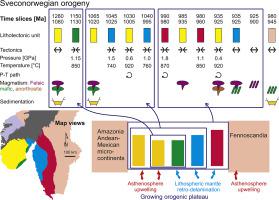当前位置:
X-MOL 学术
›
Gondwana Res.
›
论文详情
Our official English website, www.x-mol.net, welcomes your feedback! (Note: you will need to create a separate account there.)
The Sveconorwegian orogeny
Gondwana Research ( IF 6.1 ) Pub Date : 2021-02-01 , DOI: 10.1016/j.gr.2020.10.014 Bernard Bingen , Giulio Viola , Charlotte Möller , Jacqueline Vander Auwera , Antonin Laurent , Keewook Yi
Gondwana Research ( IF 6.1 ) Pub Date : 2021-02-01 , DOI: 10.1016/j.gr.2020.10.014 Bernard Bingen , Giulio Viola , Charlotte Möller , Jacqueline Vander Auwera , Antonin Laurent , Keewook Yi

|
Abstract This article reviews the geology of the Sveconorwegian orogen in south Scandinavia and existing tectonic models for the Mesoproterozoic to Neoproterozoic Sveconorwegian orogeny. It proposes an updated geodynamic scenario of large, hot, long-duration continental collision starting at c. 1065 Ma between proto-Baltica and another plate, presumably Amazonia, in a Rodinia-forming context. An orogenic plateau formed at 1280 Ma as a back-arc Cordillera-style plateau, and then grew further stepwise after 1065 Ma, as a collisional Tibetan-style plateau. Voluminous mantle- and crustal-derived Sveconorwegian magmatism took place in the hinterland in the west of the orogen, mainly: (i) bimodal magmatism at 1280–1145 Ma, overlapping with extensional intramontane basin sedimentation, (ii) the calc-alkaline Sirdal magmatic belt at 1065–1020 Ma, (iii) the hydrous ferroan hornblende-biotite granite (HBG) suite at 985–925 Ma and (iv) the anhydrous ferroan massif-type anorthosite-mangerite-charnockite (AMC) suite at 935–915 Ma. High-alumina orthopyroxene megacrysts in anorthosite imply mafic underplating at 1040 Ma and remelting of the underplates at 930 Ma. Overlapping with magmatism, protracted low-pressure, granulite-facies metamorphism reached twice ultra-high temperature conditions, of 0.6 GPa-920 °C at 1030–1005 Ma and 0.4 GPa-920 °C at 930 Ma. These features imply shallow asthenosphere under the crust. Towards the foreland in the east, metamorphism shows increasing high-pressure signature eastwards with time, with peak P-T values of 1.15 GPa-850 °C at 1150–1120 Ma in the Bamble-Kongsberg lithotectonic units, 1.5 GPa-740 °C at c. 1050 Ma in the Idefjorden lithotectonic unit, and 1.8 GPa-870 °C at c. 990 Ma in the Eastern Segment under eclogite-facies conditions. These are attributed to retreating delamination of the dense sub-continental lithospheric mantle and growth of the orogenic plateau towards the foreland. After c. 930 Ma, convergence came to a halt, the orogenic plateau collapsed, and 16 km of overburden was removed by extension and erosion.
中文翻译:

Sveconorwegian 造山运动
摘要 本文综述了斯堪的纳维亚南部斯维科诺威造山带的地质和中元古代至新元古代斯维科诺威造山带的现有构造模型。它提出了一个更新的地球动力学情景,即从 c 开始的大型、炎热、持续时间长的大陆碰撞。在原始波罗的海和另一个板块之间的 1065 Ma,大概是亚马逊,在罗迪尼亚形成的背景下。1280 Ma 形成的造山高原为弧后科迪勒拉式高原,1065 Ma 后进一步逐步扩大,为碰撞藏式高原。造山带西部腹地发生了大量地幔和地壳来源的斯韦科诺威基岩浆活动,主要有:(i) 1280-1145 Ma的双峰岩浆作用,与山内盆地的伸展沉积重叠,(ii)钙碱性Sirdal岩浆作用带在 1065–1020 Ma,(iii) 985-925 Ma 处的含水铁质角闪石-黑云母花岗岩 (HBG) 组和 (iv) 935-915 Ma 处的无水铁质地块型斜长岩-锰锰矿-碳酸镁 (AMC) 组。斜长岩中的高铝斜方辉石巨晶意味着 1040 Ma 的基性底镀层和 930 Ma 的底板重熔。与岩浆作用重叠,长期低压麻粒岩相变质作用达到两次超高温条件,1030-1005 Ma 时为 0.6 GPa-920 °C,930 Ma 时为 0.4 GPa-920 °C。这些特征意味着地壳下的浅软流圈。在东部前陆,变质作用显示出随着时间的推移向东增加的高压特征,Bamble-Kongsberg 岩石构造单元中 1150-1120 Ma 的 PT 峰值为 1.15 GPa-850 °C,c 处为 1.5 GPa-740 °C。 . Idefjorden 岩石构造单元中的 1050 Ma,和 1. 8 GPa-870 °C 在 c。榴辉岩相条件下东段990 Ma。这些归因于致密的次大陆岩石圈地幔的后退分层和造山高原向前陆的生长。在 C. 930 Ma,收敛停止,造山高原崩塌,16 公里的覆盖层被伸展和侵蚀移除。
更新日期:2021-02-01
中文翻译:

Sveconorwegian 造山运动
摘要 本文综述了斯堪的纳维亚南部斯维科诺威造山带的地质和中元古代至新元古代斯维科诺威造山带的现有构造模型。它提出了一个更新的地球动力学情景,即从 c 开始的大型、炎热、持续时间长的大陆碰撞。在原始波罗的海和另一个板块之间的 1065 Ma,大概是亚马逊,在罗迪尼亚形成的背景下。1280 Ma 形成的造山高原为弧后科迪勒拉式高原,1065 Ma 后进一步逐步扩大,为碰撞藏式高原。造山带西部腹地发生了大量地幔和地壳来源的斯韦科诺威基岩浆活动,主要有:(i) 1280-1145 Ma的双峰岩浆作用,与山内盆地的伸展沉积重叠,(ii)钙碱性Sirdal岩浆作用带在 1065–1020 Ma,(iii) 985-925 Ma 处的含水铁质角闪石-黑云母花岗岩 (HBG) 组和 (iv) 935-915 Ma 处的无水铁质地块型斜长岩-锰锰矿-碳酸镁 (AMC) 组。斜长岩中的高铝斜方辉石巨晶意味着 1040 Ma 的基性底镀层和 930 Ma 的底板重熔。与岩浆作用重叠,长期低压麻粒岩相变质作用达到两次超高温条件,1030-1005 Ma 时为 0.6 GPa-920 °C,930 Ma 时为 0.4 GPa-920 °C。这些特征意味着地壳下的浅软流圈。在东部前陆,变质作用显示出随着时间的推移向东增加的高压特征,Bamble-Kongsberg 岩石构造单元中 1150-1120 Ma 的 PT 峰值为 1.15 GPa-850 °C,c 处为 1.5 GPa-740 °C。 . Idefjorden 岩石构造单元中的 1050 Ma,和 1. 8 GPa-870 °C 在 c。榴辉岩相条件下东段990 Ma。这些归因于致密的次大陆岩石圈地幔的后退分层和造山高原向前陆的生长。在 C. 930 Ma,收敛停止,造山高原崩塌,16 公里的覆盖层被伸展和侵蚀移除。



























 京公网安备 11010802027423号
京公网安备 11010802027423号